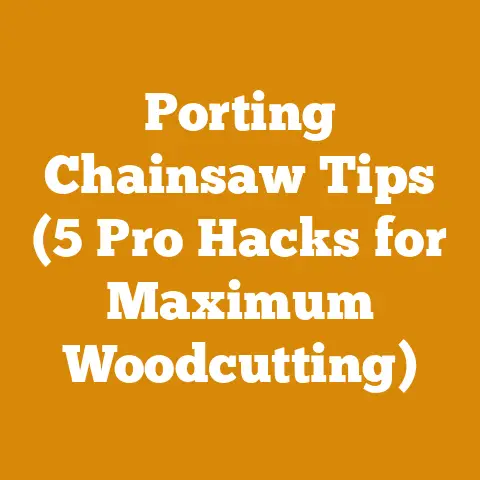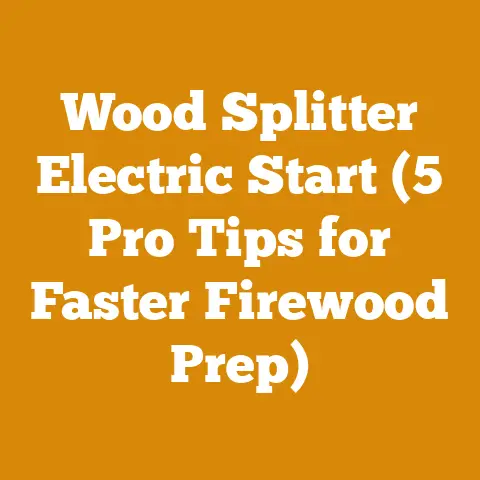Board and Batten Wood Size Guide (5 Expert Thickness Tips)
Let’s talk board and batten siding.
It’s more than just a rustic aesthetic; it’s a practical and surprisingly versatile cladding choice that, when done right, can boost your home’s curb appeal and even its energy efficiency.
The hidden benefit?
Choosing the correct wood size can significantly impact the longevity and performance of your siding, saving you time and money in the long run.
I’ve spent years working with wood, from felling trees in the Pacific Northwest to milling lumber for custom homes, and I’ve learned firsthand how crucial the right dimensions are for a successful board and batten project.
This guide will walk you through everything you need to know about selecting the perfect wood sizes for your board and batten siding.
What is Board and Batten Siding?
Board and batten siding is a traditional exterior cladding system consisting of wide vertical boards joined by narrow strips of wood, called battens, which cover the seams.
It offers a distinctive, textured look that’s both classic and contemporary.
The key to a successful installation lies in understanding the optimal dimensions for both the boards and the battens.
Why Wood Size Matters: Beyond Aesthetics
Choosing the right wood size for your board and batten siding is about more than just aesthetics.
It directly impacts:
- Durability: Thicker boards and battens are more resistant to warping, cracking, and impact damage.
- Weather Resistance: Proper dimensions help prevent water infiltration and protect your home from the elements.
- Installation Ease: Correct sizes ensure a secure and stable attachment to the wall sheathing.
- Cost-Effectiveness: Using the right amount of material minimizes waste and reduces overall project expenses.
- Aesthetic Appeal: Balanced proportions create a visually pleasing and harmonious look.
Board and Batten Wood Size Guide: The Essentials
Here’s a breakdown of the recommended dimensions for board and batten siding, along with my expert tips for making the right choices:
1. Board Thickness: Finding the Sweet Spot
The thickness of your boards is a critical factor in determining the overall durability and weather resistance of your siding.
- Recommended Thickness: I generally recommend a board thickness of at least ¾ inch (19mm) for exterior applications.
However, for added durability and a more substantial look, consider using 1-inch (25mm) thick boards. - Minimum Thickness: Avoid using boards thinner than 5/8 inch (16mm), as they may be prone to warping and cracking over time.
- Wood Species Considerations: If you’re using a softer wood species like pine, I highly recommend opting for the thicker 1-inch boards to compensate for the lower density and increased susceptibility to damage.
Hardwoods like cedar or redwood can perform well with ¾-inch thickness, but the 1-inch option will always provide a more robust and long-lasting result. Personal Story: I once worked on a project where the homeowner insisted on using ½-inch pine boards to save money.
Within a few years, the siding started to warp and crack, leading to costly repairs and replacements.
This experience taught me the importance of investing in the right materials from the outset.Takeaway: Choose a board thickness of at least ¾ inch, and consider 1 inch for enhanced durability, especially with softer wood species.
2. Board Width: Balancing Aesthetics and Practicality
The width of your boards influences the overall aesthetic of your siding and can also affect the ease of installation.
- Recommended Width: A common board width is between 6 inches (15cm) and 12 inches (30cm).
I find that 8-inch (20cm) or 10-inch (25cm) boards strike a good balance between visual appeal and ease of handling. - Wider Boards: Wider boards (12 inches) can create a more dramatic and modern look, but they may be more prone to cupping or warping, especially if the wood isn’t properly dried.
- Narrower Boards: Narrower boards (6 inches) can create a more traditional and rustic look.
They’re also easier to handle and install, particularly for DIY projects. - Spacing Considerations: The width of your boards will also determine the spacing between the battens.
A general rule of thumb is to maintain a consistent spacing that’s roughly half the width of your boards.
For example, if you’re using 8-inch boards, aim for a batten spacing of around 4 inches. Original Insight: Experiment with different board widths and batten spacings to find the combination that best suits your architectural style and personal preferences.
I often create small mock-ups with different wood sizes to help clients visualize the final result.Takeaway: Opt for board widths between 6 and 12 inches, considering the aesthetic you desire and the potential for warping with wider boards.
3. Batten Thickness: Providing Adequate Coverage
The thickness of your battens is important for ensuring proper coverage of the board seams and preventing water infiltration.
- Recommended Thickness: I recommend a batten thickness of at least 1 inch (25mm) to provide adequate coverage and create a visually appealing shadow line.
- Minimum Thickness: Avoid using battens thinner than ¾ inch (19mm), as they may not fully cover the seams and could compromise the weather resistance of your siding.
- Thicker Battens: Thicker battens (1 ¼ inch or 32mm) can create a more pronounced and dimensional look, but they may also be more expensive and require longer fasteners.
- Wood Movement: Remember to account for wood movement when selecting your batten thickness.
As the wood expands and contracts with changes in humidity, thicker battens may exert more pressure on the boards, potentially leading to cracking or warping. Case Study: In one of my projects, I used slightly thicker battens (1 ¼ inch) on a home located in a particularly wet climate.
This provided extra protection against water infiltration and helped the siding withstand the harsh weather conditions.Takeaway: Choose a batten thickness of at least 1 inch for adequate coverage and weather resistance, considering the potential for wood movement.
4. Batten Width: Achieving Visual Harmony
The width of your battens should be proportional to the width of your boards to create a visually balanced and harmonious look.
- Recommended Width: I typically recommend a batten width between 2 inches (5cm) and 4 inches (10cm).
A 3-inch (7.5cm) batten width is a versatile choice that works well with a variety of board widths. - Narrower Battens: Narrower battens (2 inches) can create a more subtle and understated look.
They’re also a good option for smaller homes or projects where you want to minimize the visual impact of the battens. - Wider Battens: Wider battens (4 inches) can create a bolder and more dramatic look.
They’re often used on larger homes or commercial buildings to add architectural interest. - Proportionality: The key is to maintain a sense of proportionality between the board width and the batten width.
As a general guideline, aim for a batten width that’s roughly one-quarter to one-third of the board width. Expert Advice: Don’t be afraid to experiment with different batten widths to find the perfect balance for your project.
I often use painter’s tape to simulate different batten widths on a section of the wall before making a final decision.Takeaway: Aim for a batten width between 2 and 4 inches, ensuring it’s proportional to the width of your boards for a visually balanced result.
5. Wood Species: Selecting the Right Material
The type of wood you choose for your board and batten siding will significantly impact its durability, appearance, and maintenance requirements.
- Cedar: Cedar is a popular choice for board and batten siding due to its natural resistance to rot, decay, and insects.
It’s also relatively lightweight and easy to work with.
Western Red Cedar is a particularly good option, as it has a beautiful grain pattern and a warm, reddish-brown color. - Redwood: Redwood is another excellent choice for exterior siding.
It’s similar to cedar in terms of its durability and resistance to decay, but it has a richer, deeper color. - Pine: Pine is a more affordable option than cedar or redwood, but it’s also more susceptible to rot and insect damage.
If you choose to use pine, be sure to treat it with a high-quality preservative and paint or stain it regularly. - Fir: Fir is a strong and stable wood that’s often used for structural applications.
It’s also a good option for board and batten siding, but it requires proper priming and painting to protect it from the elements. - Engineered Wood: Engineered wood products like fiber cement or composite siding can also be used for board and batten applications.
These materials are highly durable and require minimal maintenance, but they may not have the same natural beauty as real wood. Personal Experience: I once used reclaimed redwood for a board and batten siding project, and the results were stunning.
The redwood had a unique patina and character that added a lot of charm to the home.
However, working with reclaimed wood can be more challenging, as it may require more preparation and careful selection to ensure its suitability for exterior use.Takeaway: Consider cedar or redwood for their natural durability and resistance to decay.
If using pine or fir, ensure proper treatment and maintenance.
Additional Considerations for Board and Batten Wood Size
Beyond the basic dimensions, here are a few additional factors to keep in mind when selecting wood sizes for your board and batten siding:
- Climate: In areas with high humidity or heavy rainfall, I suggest using thicker boards and battens to provide extra protection against water infiltration.
- Budget: If you’re on a tight budget, consider using a more affordable wood species like pine or fir, but be sure to invest in proper treatment and maintenance.
- Installation Method: The way you install your board and batten siding can also affect the wood sizes you choose.
For example, if you’re using a rain screen system, you may need to adjust the thickness of your boards and battens to accommodate the air gap behind the siding. - Building Codes: Be sure to check your local building codes to ensure that your board and batten siding meets all applicable requirements.
- Wood Drying: Properly dried wood is crucial for preventing warping and cracking.
I recommend using kiln-dried lumber for your board and batten siding, as it has a lower moisture content than air-dried lumber. - Fasteners: Use high-quality, corrosion-resistant fasteners to attach your boards and battens to the wall sheathing.
I recommend using stainless steel or galvanized screws or nails. - Sealing: Seal all cut edges of the wood with a high-quality sealant to prevent water absorption.
Tools and Materials for Board and Batten Siding Installation
Here’s a list of the tools and materials you’ll need for a typical board and batten siding installation:
- Lumber: Boards and battens in the desired wood species and dimensions.
- Fasteners: Stainless steel or galvanized screws or nails.
- Sealant: High-quality exterior-grade sealant.
- Primer and Paint or Stain: For protecting and finishing the wood.
- Measuring Tape: For accurate measurements.
- Saw: Circular saw, miter saw, or hand saw for cutting the wood.
- Drill or Nail Gun: For fastening the boards and battens.
- Level: For ensuring the siding is straight and plumb.
- Safety Glasses and Gloves: For personal protection.
Step-by-Step Installation Guide
While a full installation guide is beyond the scope of this article, here’s a simplified overview of the process:
- Prepare the Wall: Ensure the wall sheathing is clean, dry, and structurally sound.
- Install a Moisture Barrier: Apply a breathable moisture barrier to the wall sheathing.
- Install the Boards: Attach the boards vertically to the wall sheathing, leaving a consistent gap between each board.
- Install the Battens: Center the battens over the seams between the boards and attach them to the wall sheathing.
- Seal and Finish: Seal all cut edges and apply primer and paint or stain to the siding.
Common Mistakes to Avoid
- Using Undersized Materials: Don’t skimp on the thickness of your boards and battens to save money.
It will only lead to problems down the road. - Improper Fastening: Make sure to use the right type and size of fasteners and space them properly to ensure a secure attachment.
- Neglecting Wood Drying: Use kiln-dried lumber to minimize the risk of warping and cracking.
- Skipping Sealing: Seal all cut edges of the wood to prevent water absorption.
- Ignoring Building Codes: Be sure to comply with all applicable building codes.
Maintaining Your Board and Batten Siding
Proper maintenance is essential for extending the life of your board and batten siding.
Here are a few tips:
- Regular Cleaning: Clean the siding regularly with a mild soap and water solution to remove dirt and debris.
- Inspect for Damage: Inspect the siding periodically for signs of damage, such as cracks, warping, or rot.
- Touch-Up Painting or Staining: Touch up any areas where the paint or stain is peeling or fading.
- Reapply Sealant: Reapply sealant to all cut edges and seams every few years.
Conclusion: Making Informed Choices
Choosing the right wood size for your board and batten siding is a critical decision that will impact its durability, appearance, and longevity.
By following the expert tips in this guide, you can make informed choices and create a beautiful and long-lasting exterior for your home.
Remember to consider the wood species, dimensions, climate, budget, and installation method when selecting your materials.
With careful planning and proper installation, your board and batten siding will provide years of beauty and protection.






